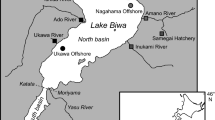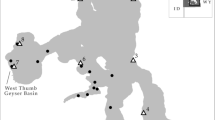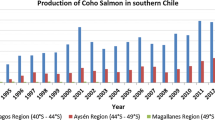Abstract
Mixed-stock fisheries which simultaneously cause mortality amongst several populations of a species of fish may occur where separate stocks partially or completely overlap in the geographic area of harvest. This study aims to analyze the population-of-origin of adult and subadult adfluvial lacustrine brown trout Salmo trutta, exploited in a mixed-stock fishery in Upper Tuloma Reservoir in Eastern Fennoscandia, using otolith microchemistry. To evaluate the origin of migratory brown trout captured in these mixed-stock harvest fisheries, we undertook otolith sampling of brown trout juveniles in fluvial spawning and rearing habitats in the reservoir watershed, including 13 natal tributaries across the catchment of the reservoir in both Russia and Finland. Harvested adult and subadult brown trout otoliths were sampled from the impoundment in the central area of the reservoir and we analyzed for stock-related character differences to compare with known populations, using trace element signatures, with fish from the mixed stock fishery. The assignments-of-origin in the mixed-stock fishery-harvest samples did not follow the known distribution of populations sampled from natal streams in the watershed. For example, brown trout from the largest tributary catchments of Lotta River and Nota River were less represented in the mixed-harvest sample, which was contradictory to their contribution to the overall spawning and rearing areas of the catchment. These results point towards the importance of maintaining the diversity of different spawning and rearing tributaries required for brown trout recruitment into mixed stock fisheries, and the potential of the existence of population structure of brown trout in the reservoir catchment. Our information suggests that it is important to develop conservation and management strategies for natal habitats in multiple streams utilized by adfluvial lacustrine brown trout populations inhabiting various catchments and that are harvested in mixed-stock fisheries.




Similar content being viewed by others
REFERENCES
Aalto, J., Niemelä, E., Julkunen, M. and Erkinaro, J., Juvenile densities, growth and migration of brown trout (Salmo trutta L.) in the Rivers Luttojoki and Nuorttijoki, northern Finland, in Kalatutkimuksia–Fiskundersokningar, Helsinki: Fin. Game and Fish. Res. Institute, 1998, vol. 138, pp. 1–38.
Andersson, A., Jansson, E., Wennerström, L., et al., Complex genetic diversity patterns of cryptic, sympatric brown trout (Salmo trutta) populations in tiny mountain lakes, Conserv. Genet., 2017, vol. 18, pp. 1–15. https://doi.org/10.1007/s10592-017-0972-4
Barnett-Johnson, R., Teel, D.J., and Casillas, E., Genetic and otolith isotopic markers identify salmon populations in the Columbia River at broad and fine geographic scales, Environ. Biol. Fishes, 2010, vol. 89, pp. 533–546. https://doi.org/10.1007/s10641-010-9662-5
Beacham, T.D., Wallace, C., Jonsen, K., et al., Accurate estimation of conservation unit contribution to coho salmon mixed-stock fisheries in British Columbia, Canada, using direct DNA sequencing for single nucleotide polymorphisms, Can. J. Fish. Aquat., 2020, vol. 77, pp. 1302–1315.
Bohlin, T., Pettersson, J., and Degerman, E., Population density of migratory and resident brown trout (Salmo trutta) in relation to altitude: Evidence for a migration cost, J. Anim. Ecol., 2001, vol. 70, pp. 112–121.
Bradbury, I.R., Hamilton, L.C., Rafferty, S., et al., Genetic evidence of local exploitation of Atlantic salmon in a coastal subsistence fishery in the Northwest Atlantic, Can. J. Fish. Aquat., 2014, vol. 72, no. 1, pp. 83–95. https://doi.org/10.1139/cjfas-2014-0058
Carlson, A.K., Bailey, P.E., Fincel, M.J., and Graeb, B.D.S., Otoliths as elemental tracers of walleye environmental history: Insights for interjurisdictional fisheries management, Lake Reserv. Manag., 2016, vol. 32, no. 4, pp. 329–340. https://doi.org/10.1080/10402381.2016.1203845
Chen, K., Ludsin, S., Marcek B.J., et al., Otolith microchemistry shows natal philopatry of walleye in western Lake Erie, J. Great Lakes Res., 2020, vol. 46, pp. 1349–1357.
Ciepiela, L.R., Walters, A.W., Life-history variation of two inland salmonids revealed through otolith microchemistry analysis, Can. J. Fish. Aquat. Sci., 2019, vol. 76, pp. 1971–1981.
Crozier, W.W., Schön, P.-J., Chaput, G. et al., Managing Atlantic salmon (Salmo salar L.) in the mixed stock environment: Challenges and considerations, ICES J. Mar. Sci., 2004, vol. 61, no. 8, pp. 1344–1358.
del Villar-Guerra, D., Larsen, M.H., Baktoft, H., et al., The influence of initial developmental status on the life-history of sea trout (Salmo trutta), Sci. Rep., 2019, vol. 9, no. 1, pp. 1–13. https://doi.org/10.1038/s41598-019-49175-0
Dodson, J.J., Sirois, P., Daigle G., et al., Otolith microstructure during the early life-history stages of brown trout: Validation and interpretation, N. Am. J. Fish. Manag., 2013, vol. 33, pp. 108–116.
Elliott, J.M., Quantitative Ecology and the Brown Trout, Oxford Series in Ecology and Evolution, Oxford: Oxford Univ. Press, 1994.
Elsdon, T.S., Wells, B.K., Campana, S.E., et al., Otolith chemistry to describe movements and life-history parameters of fishes – hypotheses, assumptions, limitations and inferences, Oceanogr. Mar. Biol., 2008, vol. 46, pp. 297–330.
Erkinaro, J., Mattsson, J., Erkinaro, H., et al., The River Tuloma salmon habitat inventory. TACIS Tuloma River Project, Work report, Helsinki: Helsinki Consulting Group Consortium ENVRUS, 9703, 2001.
Gabrielsson, R.M., Kim, J., Reid, M.R., et al., Does the trace element composition of brown trout Salmo trutta eggs remain unchanged in spawning redds?, J. Fish Biol., 2012, vol. 81, pp. 1871–1879. https://doi.org/10.1111/j.1095-8649.2012.03396.x
Gagné, F., Descriptive statistics and analysis in biochemical ecotoxicology, in Biochemical Ecotoxicology. Principles and Methods, Amsterdam: Academic Press, 2014.
Garcez, R.C.S., Humston, R., Harbor, D., and Freitas, C.E.C., Otolith geochemistry in young-of-the-year peacock bass Cichla temensis for investigating natal dispersal in the Rio Negro (Amazon–Brazil) river system, Ecol. Freshw. Fish, 2015, vol. 24, pp. 242–251. https://doi.org/10.1111/eff.12142
Geological map of the Fennoscandian shield, 2022. http://www.gigapan.com/gigapans/171438. Version 10/2022.
Hack, J., Studies of longitudinal stream profiles in Virginia and Maryland, Washington: U.S. Geological Survey Professional Paper, 294-B, 1957.
Huusko, A., Vainikka, A., Syrjänen, J., et al., Life-history of the adfluvial brown trout (Salmo trutta L.) in Eastern Fennoscandia, in Brown Trout: Biology, Ecology and Management, J. Lobón-Cerviá and N. Sanz, Eds., Hoboken: John Wiley and Sons Ltd, 2017.
Jonsson, B., and Greenberg, L., Egg incubation temperature influences the population-specific outmigration rate of juvenile brown trout Salmo trutta, J. Fish Biol., 2022, pp. 1–9. https://doi.org/10.1111/jfb.15022
Jonsson, B., and Jonsson, N., Ecology of Atlantic Salmon and Brown Trout: Habitat as a Template for Life-Histories, Dordrecht et al.: Springer, 2011.
Jonsson, B., Jonsson, N., Brodtkorb, E., and Ingebrigtsen, P.-J., Life-history traits of brown trout vary with the size of small streams, Funct. Ecol., 2001, vol. 15, pp. 310–317. https://doi.org/10.1046/j.1365-2435.2001.00528.x
Karppinen, P., Mäkinen, T., Erkinaro, J., et al., Migratory and route-seeking behaviour of ascending Atlantic salmon in the regulated River Tuloma, Hydrobiologia, 2002, vol. 483, pp. 23–30. https://doi.org/10.1023/A:1021386319633
Kendall, N.W., McMillan, J.R., Sloat, M.R., et al., Anadromy and residency in steelhead and rainbow trout (Oncorrhynchus mykiss): A review of processes and patterns, Can. J. Fish. Aquat. Sci., vol. 2015, no. 72, pp. 319–342. https://doi.org/10.1139/cjfas-2014-0192
Kerr, L.A., and Campana, S.E., Chemical composition of fish hard parts as a natural marker of fish stocks, in Stock Identification Methods: Applications in Fishery Science, London: Academic Press, 2014.
Kerr, L.A., Hintzen, N.T., Cadrin, S.X., et al., Lessons learned from practical approaches to reconcile mismatches between biological population structure and stock units of marine fish, ICES J. Mar. Sci., 2017, vol. 74, pp. 1708–1722.
King, R.A., Hillman, R., Elsmere, P., et al., Investigating patterns of straying and mixed stock exploitation of sea trout, Salmo trutta, in rivers sharing an estuary in south-west England, Fish. Manag. Ecol., 2016, vol. 23, pp. 376–389. https://doi.org/10.1111/fme.12181
Koljonen, M.-L., Gross, R., and Koskiniemi, J., Wild Estonian and Russian sea trout (Salmo trutta) in Finnish coastal sea trout catches: Results of genetic mixed-stock analysis, Hereditas, 2014, vol. 151, pp. 177–195. https://doi.org/10.1111/hrd2.00070
Lobón-Cerviá, J., Recruitment and survival rate variability in fish populations: Density-dependent regulation or further evidence of environmental determinants?, Can. J. Fish. Aquat. Sci., 2014, vol. 71, pp. 290–300.
Louhi, P., Mäki-Petäys, A., and Erkinaro, J., Spawning habitat of Atlantic salmon and brown trout: General criteria and intragravel factors, River Res. Appl., 2008, vol. 24, pp. 330–339.
Louison, M. J., and Stelzer, R. S., Use of first-order tributaries by brown trout (Salmo trutta) as nursery habitat in a cold water stream network, Ecol. Freshw. Fish, 2016, vol. 25, pp. 133–140. https://doi.org/10.1111/eff.12197
Mäkinen, H., Niva, T., Koljonen, M.-L., et al., Temporal variation in lake run brown trout (Salmo trutta) mixed-stock fishery catches in a large Fennoscandian lake, Boreal Environ. Res., vol. 20, no. 5, pp. 651–665.
Martin, J., Bareille, G., Berail, S., et al., Persistence of a southern Atlantic salmon population: Diversity of natal origins from otolith elemental and Sr isotopic signatures, Can. J. Fish. Aquat. Sci., 2013, vol. 70, pp. 182–197. https://doi.org/10.1139/cjfas-2012-0284
Mikheev, P., Jarvis, M.G., Matthaei, C.D., et al., Geomorphological features drive spatiotemporal dynamics of young-of-the-year brown trout populations in a large New Zealand river catchment, Freshw. Biol., 2020, vol. 65 pp. 1392–1400.
Mikheev, P.B., Jarvis, M.G., Matthaei, C.D., et al., Straying of brown trout in the catchment of a large New Zealand river evaluated by otolith microchemistry, Ecol. Freshw. Fish., 2021, vol. 30, no. 4, pp. 433–443. https://doi.org/10.1111/eff.12595
Murmansk Regional Directorate on Conservation and Enhancement of Fish Resources, in Annual Report for 1989 on Verkhnetulomskiy Reservoir, Murmansk: Murmanrybvod, 1989.
Nehlsen, W., Williams, J.E., and Lichatowich, J.A., Pacific Salmon at the Crossroads: Stocks at Risk from California, Oregon, Idaho, and Washington, Fisheries, 1991, vol. 16, pp. 4–21.
Olley, R., Young, R.G., Closs, G.P., et al., Recruitment sources of brown trout identified by otolith trace element signatures, N. Z. J. Mar. Freshwater Res., 2011, vol. 45, no. 3, pp. 395–411. https://doi.org/10.1080/00288330.2011.592196
Olsson, I.C., Greenberg, L.A., Bergman, E., Wysujack, K., Environmentally induced migration: The importance of food, Ecol. Lett., 2006, vol. 9, no. 6, pp. 645–651.
Orell, P., Erkinaro, J., Mäkinen, H., and Seppänen, M., Taimenseurannat Tuulomajoen vesistön Suomen puolen latvajoissa 2011–2014 (Monitoring of Brown Trout Populations in the Finnish Headwaters of the Tuloma System 2011–2014), Oulu: Nat. Res. Institute Finland, 2015.
Pangle, K.L., Ludsin, S.A., Fryer, B.J., Otolith microchemistry as a stock identification tool for freshwater fishes: Testing its limits in Lake Erie, Can. J. Fish. Aquat. Sci., 2010, vol. 67, pp. 1475–1489. https://doi.org/10.1139/F10-076
Piccolo, J.J., Norrgård, J.R., Greenberg, L.A., et al., Conservation of endemic landlocked salmonids in regulated rivers: A case-study from Lake Vänern, Sweden, Fish Fish., 2012, vol. 13, no. 4, pp. 418–433.
Prichard, C.G., Student, J.J., Jonas, J.L., et al., Geologic variability underlying stream catchment areas correlates with fish otolith microchemistry across disparate glacial till depths, Fish. Res., 2019, vol. 216, pp. 109–119. https://doi.org/10.1016/j.fishres.2019.04.006
Prusov, S.V., Zubchenko, A.V., Alexeev, M.Yu., et al., Sostoyanie zapasov i rybolovstva anadromnykh ryb Murmanskoi oblasti (Status Of Anadromous Fish Stocks and Fisheries in Murmansk Region), Murmansk: Polyar. Inst. Rybn. Khoz. Okeanogr., 2021.
R Core Team, R: A Language and Environment For Statistical Computing, Vienna: R Foundation for Statistical Computing, 2017. http://www.R-project.org.
Rosenfeld, J.S., Macdonald, S., Foster, D., et al., Importance of small streams as rearing habitat for coastal cutthroat trout, N. Am. J. Fish. Manag., 2002, vol. 22, pp. 177–187.
Ruokonen, T.J., Kiljunen, M., Erkinaro, J., et al., Migration strategies of brown trout (Salmo trutta) in a subarctic river system as revealed by stable isotope analysis, Ecol. Freshw. Fish., 2019, vol. 28, pp. 53–61.
Ryan, D., Shephard, S., and Kelly, F.L., Temporal stability and rates of post-depositional change in geochemical signatures of brown trout Salmo trutta scales, J. Fish Biol., 2016, vol. 89, pp. 1704–1719. https://doi.org/10.1111/jfb.13081
Shuster, B.I., Brown trout (Salmo trutta L.) of the Verkhnetulomskoe reservoir, in Rybokhozyaystvennye issledovaniya Verkhnetulomskogo i Serebryanskogo vodokhranilishch Murmanskoi oblasti, Sbornik nauchnykh trudov (Fisheries Research in Verkhnetulomskoe and Serebryanskoe Reservoirs of Murmansk Region, Collection of Scientific Papers), Murmansk: Polyar. Inst. Rybn. Khoz. Okeanogr., 1985.
Swatdipong, A., Vasemägi, A., Niva, T., et al., High level of population genetic structuring in lake-run brown trout, Salmo trutta, of the Inari Basin, northern Finland, J. Fish Biol., 2010, vol. 77, pp. 2048–2071. https://doi.org/10.1111/j.1095-8649.2010.02784.x
Syrjänen, J., Vainikka, A., Louhi, P. et al., History, conservation and management of adfluvial brown trout stocks in Finland, in Brown Trout: Biology, Ecology and Management, J. Lobón-Cerviá and N. Sanz, Eds., Hoboken: John Wiley and Sons Ltd., 2018. https://doi.org/10.1002/9781119268352.ch28
Tretyak, V.L., Rudneva G.B., and Zubchenko A.V., Assessment of Optimal Spawning Stock and Factors Affecting the Abundance of Atlantic Salmon in the Tuloma River, Copenhagen: ICES, 1997.
Vähä, J.-P., Erkinaro, J., Falkegård, M., et al., Genetic stock identification of Atlantic salmon and its evaluation in a large population complex, Can. J. Fish. Aquat. Sci., 2017, vol. 74, no. 3, pp. 327–338. https://doi.org/10.1139/cjfas-2015-0606
Vatland, S., and Caudron, A., Movement and early survival of age-0 brown trout, Freshw. Biol., 2015, vol. 60, pp. 1252–1262. https://doi.org/10.1111/fwb.12551
Veinott, G., Westley, P.A.H., Warner, L., and Purchase, C.F., Assigning origins in a potentially mixedstock recreational sea trout (Salmo trutta) fishery, Ecol. Freshw. Fish, 2012, vol. 21, no. 4, pp. 541–551. https://doi.org/10.1111/j.1600-0633.2012.00574.x
Warburton, M.L., Jarvis, M.G., and Closs, G.P., Otolith microchemistry indicates regional phylopatry in the larval phase of an amphidromous fish (Gobiomorphus hubbsi), N. Z. J. Mar. Freshw. Res., 2018, vol. 52, pp. 398–408. https://doi.org/10.1080/00288330.2017.1421237
Watson, N.M., Prichard, C.G., Jonas, J.L., et al., Otolith-chemistry-based discrimination of wild- and hatchery-origin Steelhead across the Lake Michigan basin, N. Am. J. Fish. Manag., 2018, vol. 38, pp. 820–832.
Whitledge, G.W., Chapman, D.C., Farver, J.R., et al., Identifying sources and year classes contributing to invasive grass carp in the Laurentian Great Lakes, J. Great Lakes Res., 2021, vol. 47, pp. 14–28.
Young, K.A., Gaskell, P., Jacklin, T., and Williams, J.E., Brown trout management for the 21st century, in Brown Trout: Biology, Ecology and Management, J. Lobón-Cerviá and N. Sanz, Eds., Hoboken: John Wiley and Sons Ltd., 2018.
ACKNOWLEDGMENTS
The authors thank Theo Caféé (Comprehensive School Raymond Savignac, Villefranche-de-Rouergue, France) and Nicky McHugh (University of Otago, Dunedin, New Zealand) for help in the laboratory. We would like to thank anonymous reviewers for their constructive comments on this manuscript.
Funding
This study was supported with funds from the University of Otago Doctoral Scholarship awarded to Pavel Mikheev, Barry Jonassen Award provided by Australian Society for Fish Biology, as well as with the partial support of the grant of the Ministry of Education and Science of the Russian Federation project no. 2019-0858 “Biogeochemical and geochemical studies of landscapes in the conditions of the development of mineral deposits, the search for new methods of monitoring and forecasting the state of the environment”.
Author information
Authors and Affiliations
Corresponding author
Ethics declarations
Conflict of interests. The authors declare that they have no conflicts of interest.
Statement on the welfare of humans or animals. All applicable international, national, and/or institutional guidelines for the care and use of animals were followed.
Supplementary Information
Rights and permissions
About this article
Cite this article
Mikheev, P.B., Prusov, S.V., Erkinaro, J. et al. Tributary-Specific Contribution to a Lacustrine Mixed-Stock Fishery of Brown Trout Salmo trutta (Salmonidae) in a Diverse Sub-Arctic Watershed. J. Ichthyol. 63, 319–332 (2023). https://doi.org/10.1134/S0032945223020121
Received:
Revised:
Accepted:
Published:
Issue Date:
DOI: https://doi.org/10.1134/S0032945223020121




